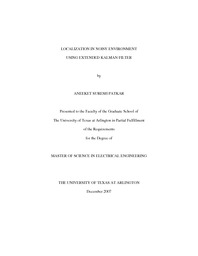
ATTENTION: The works hosted here are being migrated to a new repository that will consolidate resources, improve discoverability, and better show UTA's research impact on the global community. We will update authors as the migration progresses. Please see MavMatrix for more information.
Show simple item record
| dc.contributor.author | Patkar, Aneeket Suresh | en_US |
| dc.date.accessioned | 2008-04-22T02:41:17Z | |
| dc.date.available | 2008-04-22T02:41:17Z | |
| dc.date.issued | 2008-04-22T02:41:17Z | |
| dc.date.submitted | December 2007 | en_US |
| dc.identifier.other | DISS-1985 | en_US |
| dc.identifier.uri | http://hdl.handle.net/10106/775 | |
| dc.description.abstract | Localization is an important aspect of Wireless Sensor Networks. Information regarding the position of the sensor nodes is not always known. Without the position information of the sensors, the data reported by the sensors is of little use. Various approaches have been used to perform localization using some information about the sensor node. Potential field approach for localization, using distance information has been successfully tested with satisfactory results.
However in case of noisy environment, the range measurements have greater inaccuracy. In such cases, localization using the above algorithm can provide some inaccuracy. To rectify such erroneous localization situations, Extended Kalman Filters are used to estimate the position. The Extended Kalman Filter has been used as the process for estimation of coordinates is a non-linear process. The EKF is a recursive filter which only needs the information from the previous state to predict the next state. My Contributions to the thesis :
1. Programmed the Cricket in TinyOS to store the distance measurement in
arrays and then broadcast the same over radio to other crickets. The cricket
programmed as a base station only listens on the radio and then send the
received message to the PC over the serial UART.
2. Created a LabVIEW application which processes the message received from
the cricket base station and deciphers the message to extract the distance
measurements. The node id is used to identify the transmitting node and the
distances are stored in corresponding arrays. The ranging information in
then written into a file.
3. Created a LabVIEW application to read the distances stored in the file and
then arrange the readings depending on the number of nodes.
4. Implemented the Extended Kalman Filter Localization algorithm for relative
and absolute localization algorithm.
5. Implemented V-shaped swarm behavior demonstration using three Garcia as
the robot and cricket as the motion guiding tool. | en_US |
| dc.description.sponsorship | Lewis, Frank | en_US |
| dc.language.iso | EN | en_US |
| dc.publisher | Electrical Engineering | en_US |
| dc.title | Localization In Noisy Environment Using Extended Kalman Filter | en_US |
| dc.type | M.S. | en_US |
| dc.contributor.committeeChair | Lewis, Frank | en_US |
| dc.degree.department | Electrical Engineering | en_US |
| dc.degree.discipline | Electrical Engineering | en_US |
| dc.degree.grantor | University of Texas at Arlington | en_US |
| dc.degree.level | masters | en_US |
| dc.degree.name | M.S. | en_US |
| dc.identifier.externalLink | https://www.uta.edu/ra/real/editprofile.php?onlyview=1&pid=27 | |
| dc.identifier.externalLinkDescription | Link to Research Profiles | |
Files in this item
- Name:
- umi-uta-1985.pdf
- Size:
- 26.17Mb
- Format:
- PDF
This item appears in the following Collection(s)
Show simple item record


